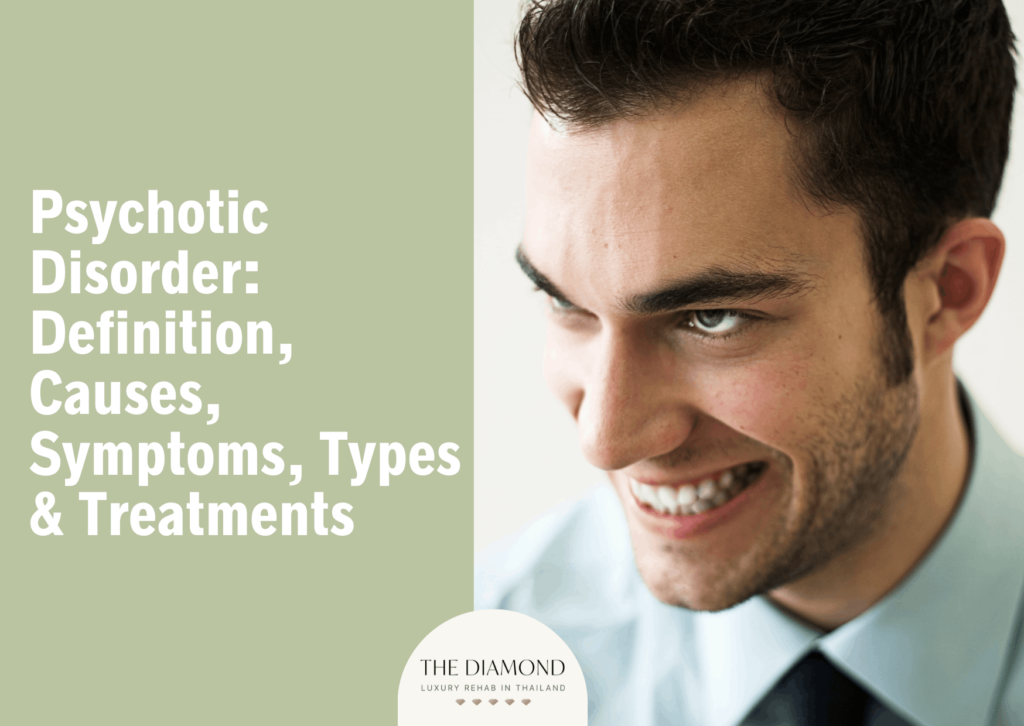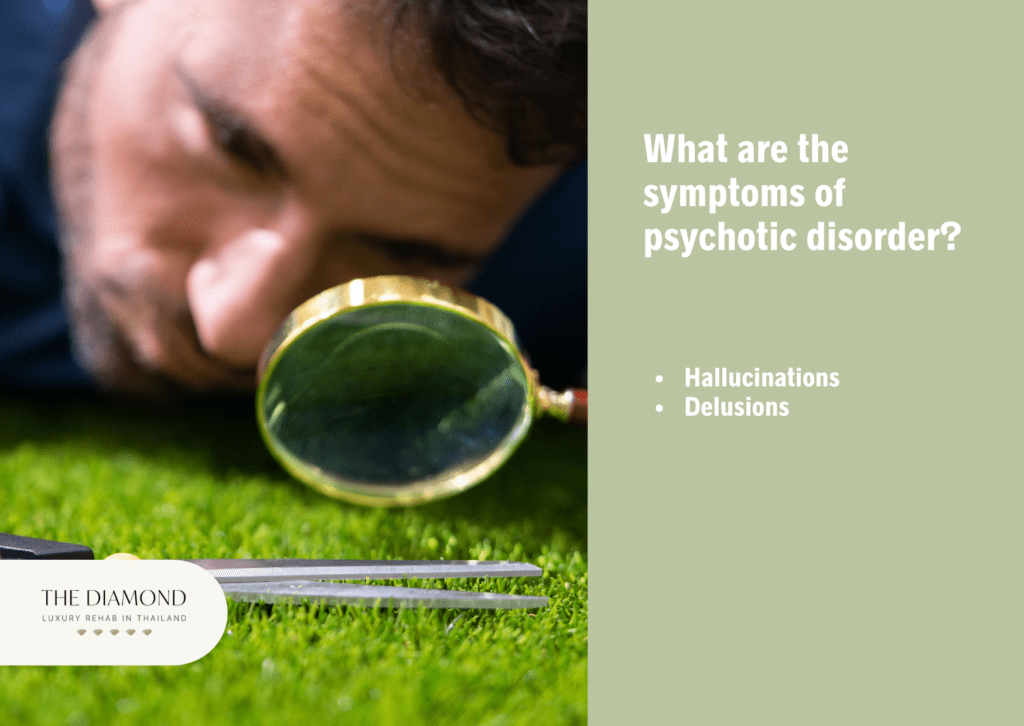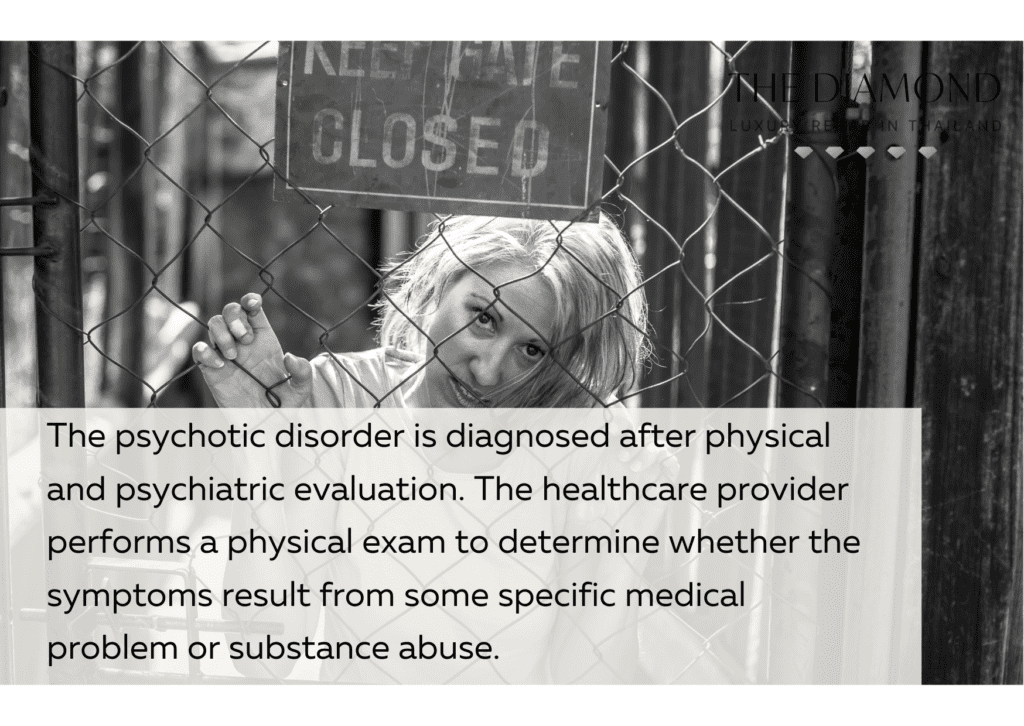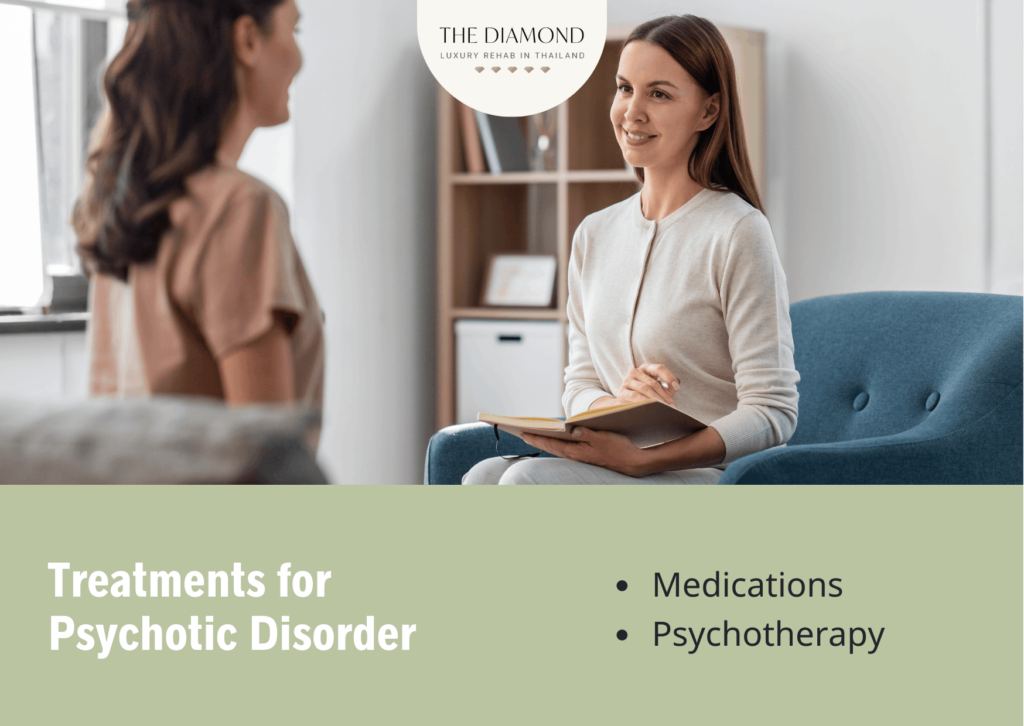Psychotic disorder: definition, causes, symptoms, types and treatments
Table of content
- What is psychotic disorder?
- What are the causes of psychotic disorder?
- What are the symptoms of psychotic disorder?
- What are the types of psychotic disorders?
- What are the treatments for psychotic disorder?

Psychotic disorder is an umbrella term that refers to a group of mental illnesses indicated by symptoms of psychosis, which change the way a person perceives reality.
The causes of psychotic disorders include genetics, stress, and drug abuse.
The main symptoms of psychotic disorders are hallucinations and delusions. However, people experience other symptoms as well, including lack of interest, paranoia, and social withdrawal.
The types of psychotic disorders include schizophrenia, schizoaffective disorder, schizophreniform disorder, brief psychotic disorder, delusional disorder, shared psychotic disorder, substance-induced psychotic disorder, and paraphrenia.
The main treatment approach for psychotic disorders is medications and psychotherapy.
What is psychotic disorder?
Psychotic disorder is a group of mental illnesses that affect the way a person perceives reality and the world around them. These mental illnesses are characterized by symptoms of psychosis, such as hallucinations and delusions. In a nutshell, psychotic disorder is not a single mental illness. It’s a category to which several mental illnesses belong.
These disorders are included in the Diagnostic and Statistical Manual of Mental Disorders, Fifth Edition (DSM-5) by the American Psychiatric Association in the chapter called Schizophrenia Spectrum and Other Psychotic Disorders.
The psychotic disorder isn’t a modern-day mental health problem. The concept of psychosis in psychiatric literature was introduced in 1841 by Karl Friedrich Canstatt, a German physician. The term he used was psychic neurosis, which initially referred to all diseases of the nervous system. However, Canstatt focused on the psychic manifestation of a disease affecting the brain.
The Austrian physician Ernst von Feuchtersleben used the term psychosis in 1845 as he described a change in personality and the interaction between mental and physical processes. In the second half of the 19th century, the term psychosis was widely used, but it referred mainly to mental illnesses in general.
In 1924, a German psychiatrist Oswald Bumke discussed an equation between different types of psychoses which led to the term psychosis getting the meaning that is still valid today.
Although the history of psychotic disorders is generally considered to start with the term psychosis, it is traced back to ancient times. For instance, Chinese texts from over 3000 years ago mentioned neuropsychiatric illnesses indicated by mania and symptoms of psychosis with or without epilepsy.
How common is psychotic disorder?
Psychotic disorder is relatively uncommon, as the median lifetime prevalence for psychotic illnesses was 7.49 per 1000, while the pooled median point and 12-month prevalence were 3.89 and 4.03 per 1000, respectively, according to a 2018 paper by Berta Moreno-Küstner and Carlos Martín published in PLoS One. Numbers show these disorders affect 1% of the population. They affect men and women equally, but males usually have an earlier onset of the symptoms.
According to a review from Stevens et al., published in the March 2014 issue of The Primary Care Companion for CNS Disorders, 14% of 11-year-old children who were interviewed acknowledged having psychotic symptoms, which were linked to a 5- to 16-fold higher risk of psychotic disorder in the early stages of adulthood.
Since then, numerous large-scale population-based studies have examined the prevalence of psychotic symptoms in teenagers. Interview-based studies have reported rates ranging from 9% to 14%, while research utilizing self-report questionnaires have indicated rates as high as 25%.
The prevalence of psychotic symptoms in older adults was 5.2% in a study of the Asian population, as per a 2016 study by Subramaniam et al., published in International Psychogeriatrics.
When it comes to specific disorders, schizophrenia affects around 24 million people in the world or 0.32% of the population. In other words, it affects one in 300 people, according to a 2022 fact sheet titled, “Schizophrenia” from the World Health Organization. In the United States, schizophrenia affects 2.8 million adults or 1.1% of the population.
When it comes to children and teens, a 2019 study by Sandeep Grover and Ajit Avasthi published in the Indian Journal of Psychiatry stated that 0.4% of children and adolescents aged 5 to 18 years are affected by a variety of psychotic disorders.
Between 0.1% and 0.5% of people aged 65 or older have schizophrenia, whereas the prevalence among the 45-64 years age group is 0.6%, as per a 2009 article written by Rosenberg et al., for the Annals of Long-Term Care.
Men and women are equally affected by schizophrenia, but males usually develop this mental illness between the ages of 15 and 25. On the other hand, women tend to develop schizophrenia between 20 and 35 years of age.
Other psychotic disorders are rare as well. For example, the prevalence of delusional disorder in the United States is 0.02%, according to an article titled, “Delusional Disorder” last updated in June 2022 by Medscape. A 2010 paper by Portugal et al., in Psychiatry Research revealed that the female-to-male ratio of the prevalence of the delusional disorder is 1.6:1.
Since these disorders are uncommon, data regarding their prevalence is scarce.
What are the causes of psychotic disorder?
The causes of psychotic disorder involve multiple factors that are implicated in its development. The biggest causes of psychotic disorder are listed below.
- Genetic factors
- Stress
- Drug abuse
1. Genetic factors
Genetic factors refer to the heredity of psychotic disorders due to genetic mutations. Several mental illnesses tend to run in families, and psychotic disorder isn’t an exception.
According to a 2019 study by Legge et al., published in JAMA Psychiatry, twin research and genome-wide association studies (GWASs) have demonstrated the heritability of psychotic experiences. Several genes and their mutations are involved in the development of these disorders rather than just one gene.
Additionally, a review from Dadouh et al., published in the February 2016 issue of the European Journal of Medical Genetics asserted that a multitude of studies have validated the presence of a robust and intricate genetic component in the susceptibility to psychotic illnesses. Still, little is known regarding the genetic underpinnings of these disorders.
2. Stress
Stress is a normal reaction of the body as a response to any type of change that causes physical, emotional, or psychological strain. It’s the way humans react to stressful stimuli from the environment. While normal and healthy, stress is considered a huge problem when it becomes persistent (chronic) or poorly managed.
When stress is unmanaged properly, it causes a wide range of problems. It contributes to the development of psychoactive disorder as well. In 2008, Schizophrenia Bulletin published a paper by van Winkel et al., that showed that stress plays a major role in the onset of psychosis.
Multiple mechanisms of action are involved. For example, stress acts on the hypothalamus-pituitary-adrenal (HPA) axis, whose function is to mediate the principal adaptive response to stress.
In certain cases, the stress response is enhanced, and the HPA axis triggers a chain of reactions that result in the dysfunction of neural circuits and changes in dopamine signaling. This potentially plays a role in the development of psychosis and psychotic disorder. High levels of stress affect the dopaminergic activity and thereby contribute to the development of this mental illness.
Lastly, a 2002 study titled, “Could Stress Cause Psychosis in Individuals Vulnerable to Schizophrenia?” from the CNS Spectrums revealed stress may cause psychosis in vulnerable individuals through its impact on dopamine. More research on this subject is necessary to understand all the ways through which stress contributes to the development of psychotic disorder.
3. Drug abuse
Drug abuse is defined as the use of certain substances to experience pleasurable effects on the brain or the excessive, addictive, and maladaptive use of prescription medications for nonmedical purposes.
The earlier someone starts abusing drugs, the more susceptible they are to developing mental conditions, including psychosis and psychotic disorders. Drug addiction contributes to psychotic disorders because it creates a biological vulnerability that makes the brain more prone to changes that lead to psychosis.
Early exposure to substances is particularly problematic because the brain is still developing, and psychoactive drugs affect that process. Not only does the use of drugs contribute to psychotic disorder, but withdrawal from them as well.
What are the symptoms of psychotic disorder?

The symptoms of psychotic disorder vary from one type to another. The symptoms of psychotic disorder are listed below.
- Hallucinations
- Delusions
1. Hallucinations
Hallucination is defined as a false sensory experience. To the affected person, hallucinations seem real, but they’re not. The most common hallucinations are auditory and visual i.e., involving hearing and sight. More precisely, a person with hallucinations hears or sees things that aren’t real. That said, certain people have hallucinations involving other senses.
The causes of hallucinations are physical and psychological. These sensory experiences have a major impact on a person’s health and well-being. The effects are largely physical and behavioral.
The physical effects of hallucinations revolve around a lack of self-care, which leads to numerous health problems ranging from tooth decay to weight gain and a higher risk of diabetes and cardiovascular diseases.
Behavioral effects of hallucinations include frustration, anger, a high risk of self-harm, suicidal ideation, social withdrawal, and poor functioning at home or school. To others, people with hallucinations come across as distant, disoriented, and not motivated to participate in activities with other interests.
2. Delusions
A delusion is defined as a false belief that contradicts reality and is not based on evidence or any argument that validates it. The presence of delusions points to an abnormality in the content of thought. The main difference between hallucinations and delusions is that the latter is a false belief, whereas the former is a false sensory experience.
Misinterpretation of events reinforces delusions. Various cases of delusions involve paranoia to a certain extent.
Like hallucinations, delusions have a strong impact on every aspect of a person’s life. Physical effects of delusions include poor blood sugar control, cardiovascular diseases, poor personal hygiene, periodontal disease and low energy levels.
Behavioral effects of delusions include aggressiveness toward oneself and others, unusual or abnormal behavior, excessive antagonism, lack of motivation and emotion, and difficulty functioning in daily life.
What are the types of psychotic disorders?
Types of psychotic disorder have their own set of symptoms and severity levels. The different types of psychotic disorder are listed below.
- Schizophrenia
- Schizoaffective disorder
- Schizophreniform disorder
- Brief psychotic disorder
- Delusional disorder
- Shared psychotic disorder
- Substance-induced psychotic disorder
- Paraphrenia
1. Schizophrenia
Schizophrenia is a serious mental disorder indicated by the abnormal perception of reality. It causes psychosis and is linked to significant disability. Schizophrenia is often mistaken for multiple personality disorder (now known as dissociative identity disorder), as people think people with schizophrenia have several personalities.
The reality is that persons with schizophrenia don’t have multiple personalities; their mental illness consists of hallucinations and other symptoms.
According to the World Health Organization (WHO)’s 2022 fact sheet titled, “Schizophrenia,” the exact cause of schizophrenia is still unknown. Scientists theorize that the interaction between genes and several environmental factors play a role.
Brain chemistry, such as the impaired balance of neurotransmitters, including dopamine, serotonin, and glutamate, and changes in brain structure contribute to the development of schizophrenia.
Other potential causes of schizophrenia include pregnancy and birth complications such as malnutrition and exposure to viruses and chemicals in the womb. Alcohol and drug abuse, particularly the use of mind-altering or hallucinogenic drugs, additionally contribute to the onset of schizophrenia.
Symptoms of schizophrenia are positive and negative. Positive symptoms are thoughts and behaviors that a person didn’t have before schizophrenia. Examples are hallucinations, delusions, disorganized speech, and abnormal motor behavior.
On the other hand, negative symptoms are behaviors or thoughts and skills that schizophrenia impaired. Good examples of negative symptoms are social withdrawal, lack of personal hygiene, lack of emotion, and lack of ability to feel pleasure.
Schizophrenia has a wide range of effects on a person’s life and well-being. When left untreated, it leads to anxiety and depression, substance abuse, social isolation, inability to work or attend school, financial problems, health and medical problems, aggressiveness, and suicidal thoughts and tendencies.
The main difference between schizophrenia and other psychotic disorders, such as brief psychotic disorder, is in the duration of psychosis. Unlike delusional disorder, schizophrenia includes other positive and negative symptoms as well, not just delusions.
Substance-induced psychotic disorder occurs mainly due to substance abuse, whereas schizophrenia is a more complicated psychotic disorder that occurs due to a combination of different factors.
When it comes to comparison to other mental disorders, schizophrenia is characterized by psychosis and the condition changes the way people think, feel, behave, and perceive reality.
2. Schizoaffective disorder
Schizoaffective disorder is a combination of symptoms of schizophrenia and a mood disorder. Since this disorder is poorly studied, numerous people are diagnosed either with schizophrenia or bipolar disorder despite having symptoms of both illnesses.
While the exact cause of schizoaffective disorder is unknown, genetics is a likely factor i.e., it tends to run in families. According to an article titled, “Schizoaffective Disorder” from the National Alliance on Mental Illness, there are variations in brain structure and function in people with schizoaffective disorder. Other potential causes of this disorder are stress or trauma and drug use.
Symptoms of schizoaffective disorder tend to vary from one person to another. People with this disorder experience schizophrenia symptoms such as hallucinations, delusions, bizarre or unusual behavior, and impaired speech. At the same time, they experience symptoms of bipolar disorder, such as periods of manic (euphoric) mood, depression, problems with managing personal care, and impaired occupational and social functioning.
Effects of schizoaffective disorder, especially if not managed properly, include social isolation, unemployment, anxiety, depression, interpersonal and family conflicts, substance abuse, health problems, poverty, and suicidal thoughts and tendencies.
What makes schizoaffective disorder different from schizophrenia is that the latter doesn’t include symptoms of bipolar disorder. It differs from other psychotic disorders because of the length of psychosis (psychotic episode lasts at least two weeks), and unlike delusional disorder, schizoaffective disorder involves manic and depressive symptoms besides delusions.
The similarity between this and other psychotic disorders on the list is the presence of psychosis.
3. Schizophreniform disorder
Schizophreniform disorder is a psychotic illness indicated by symptoms that last six months or less. A 2022 article written by Zawn Villines for Medical News Today described it as a placeholder for a schizophrenia diagnosis. Since people with schizophreniform disorder have psychosis, they believe things that are contrary to reality and have sensory experiences that other people do not.
Due to schizophreniform disorder being a multifactorial disease, several factors are involved in its development. Potential causes include genetics, childhood trauma, and exposure to certain viruses in an infant’s development.
Additionally, hormonal and chemical changes contribute to the development of schizophreniform disorder. Environmental factors such as low birth weight, preeclampsia in the mother during pregnancy, and being born in winter are contributing factors to the onset of schizophreniform disorder as well.
The primary symptom of schizophreniform disorder is psychosis, which includes delusions, hallucinations, and chaotic or unusual thinking. These symptoms cause anxiety and paranoia. Other symptoms of schizophreniform disorder include low motivation, depression-like symptoms, and changes in speech.
The biggest effects of schizophreniform disorder include developing schizophrenia, depression, and a high risk of suicide.
Schizophreniform disorder is different from schizophrenia because the latter is a lifelong condition. On the flip side, schizophreniform disorder is temporary. Duration of psychosis is the main feature that makes schizophreniform disorder stand out in the group of psychotic disorders. Compared to delusional disorder, which involves delusions as the primary symptom, schizophreniform disorder is indicated by psychosis and symptoms such as loss of interest.
Similarity between schizophreniform and other psychotic disorders is in their causes and symptoms of psychosis. For example, schizophreniform disorder includes symptoms such as impaired perception of reality and bizarre behaviors.
4. Brief psychotic disorder
Brief psychotic disorder is the presence of one or more psychotic symptoms with a sudden onset and full remission within one month. The symptoms of this disorder last between 24 hours and 30 days. While people get into remission quickly, there’s a potential for relapse in the future.
The main causes of brief psychotic disorder are extreme stress or trauma.
Symptoms of this disorder include delusions, hallucinations, and disorganized speech. People have catatonic or disorganized and odd behaviors as well.
Effects of brief psychotic disorder include anxiety, impaired performance at home or school, and problems with relationships due to odd behaviors.
Brief psychotic disorder differs from schizophrenia because the latter is a long-term condition. Additionally, as opposed to schizophreniform disorder, which lasts around six months, brief psychotic disorder lasts up to a month.
The main similarity between brief psychotic disorders and other disorders is the presence of psychosis and odd or strange behaviors.
5. Delusional disorder
Delusional disorder is a type of mental illness wherein a person doesn’t know what’s real or imagined. People with this disorder have one or more delusions i.e., false beliefs in something that’s not true or not based on evidence and reality.
There are different types of delusional disorders, such as erotomanic, grandiose, jealous, persecutory, somatic, and mixed. Someone with erotomanic delusions believes someone, e.g,. a celebrity is in love with them, whereas grandiose delusions include an over-inflated sense of self-worth.
A person with the jealous type of delusions believes their significant other is unfaithful without any evidence. Persecutory delusions are beliefs of being mistreated or threatened by someone. Somatic delusions are beliefs of having a medical problem. People with mixed delusions usually have more than one type of other delusions.
The most likely causes of delusional disorder are genetic predisposition, abnormalities in certain brain areas, imbalance of brain neurotransmitters, and environmental and psychological factors, including stress, alcoholism and substance abuse, suspicion, and envy.
Symptoms of the delusional disorder depend on the type of delusion. People with jealous or persecutory delusions exhibit anger and violent behavior. Patients with delusional disorder additionally experience symptoms such as holding grudges, feelings of being exploited, and being preoccupied with the loyalty of others.
Effects of delusional disorder include depression, legal issues, and self-harm or harm to others.
Delusional disorder is different from schizophrenia because it doesn’t involve psychotic symptoms other than delusions. The same is the difference between this and other types of psychotic disorder.
The presence of delusions i.e. psychosis, is the main similarity between delusional disorder and other mental illnesses on this list.
6. Shared psychotic disorder
Shared psychotic disorder, also known as folie à deux, is a rare mental illness that two or more people in a close relationship share. In this disorder, an inducer (or primary) is a person with psychotic disorder and delusions.
The inducer influences people (secondary) without psychotic disorder based on delusional beliefs. In most cases, shared psychotic disorder affects two people, but sometimes it includes larger groups, even families.
Multiple causes are associated with a shared psychotic disorder. For example, primary and secondary are possibly socially isolated from the outside world, which contributes to the onset of symptoms.
Other potential causes are high levels of chronic stress, the close connection between primary and secondary, an untreated disorder such as schizophrenia, and an age difference between two people.
Additionally, temperament plays a role. For example, the primary is dominant, whereas the secondary is submissive, which gives in to keep peace and later beliefs in delusions. A secondary person is often neurotic, passive, and struggles with critical thinking.
They are likely to have another mental illness as well, such as depression. Shared psychotic disorder occurs when the secondary is mentally or physically dependent on the primary. Being female is among the factors that contribute to the development of a shared psychotic disorder.
Symptoms of a shared psychotic disorder depend on the specific diagnosis of the primary. The disorder mainly includes delusions, but the secondary develops them gradually. In addition to this symptom, the affected individuals are paranoid, fearful, and suspicious of others. They are typically angry and defensive, too.
Since neither of the affected persons is aware that what they believe isn’t true, the disorder affects how they behave. The effects of this disorder extend to problems with physical health due to high levels of cortisol (stress hormone). Other effects include anxiety, depression, and struggles with aspects of daily living.
The biggest difference between this and other psychotic disorders is that shared psychotic disorder affects two or more people. One person has a specific psychotic illness, whereas the other develops delusions.
The similarity between these disorders is in delusions as symptoms and the effects on daily living.
7. Substance-induced psychotic disorder
Substance-induced psychotic disorder is a mental illness where the onset of psychotic symptoms is associated with starting or stopping drug use. In other words, the condition occurs with intoxication or withdrawal.
These drugs include prescription medications such as analgesics, anticholinergics, antiepileptics, antidepressants, steroids, muscle relaxants, disulfiram, and medications for Parkinson’s disease. Psychoactive substances are usually involved with this disorder, and they include cannabis, alcohol, PCP, hallucinogens, inhalants, stimulants, hypnotics, and sedatives.
Even though it’s called a substance-induced psychotic disorder, the substance alone doesn’t cause the symptoms of psychosis. Instead, drugs trigger psychosis in people who are at a higher risk of developing these symptoms.
Co-occurring mental health disorders contribute to the development of this mental illness. Being male, or younger than 30, increases the risk of substance-induced psychotic disorder as well.
Symptoms of substance-induced psychotic disorder are hallucinations and delusions. Duration of symptoms depends on the medical history of a person, when the substance was ingested, the type of the substance, and the amount taken.
Effects of this disorder include trouble taking care of oneself, social withdrawal, and communication problems.
Unlike schizophrenia, this disorder is usually temporary, with symptoms lasting under a month. Once the withdrawal process completes, people tend to stop experiencing symptoms of substance-induced psychotic disorder.
It is important to note that people don’t experience psychosis before substance use or withdrawal. What makes this disorder different from others is that drugs or other substances are the main triggers.
The similarity between substance-induced psychotic disorder and other conditions on this list is in symptoms of psychosis. Similar to schizophreniform and brief psychotic disorder, this condition is temporary.
8. Paraphrenia
Paraphrenia is a mental illness characterized by paranoid delusions. A person with paraphrenia experiences imaginary anxieties or fears that are usually exaggerated. However, the disorder doesn’t affect their intellectual capabilities. Paraphrenia usually affects older adults.
It’s not entirely clear what causes paraphrenia, but severe neurological illness and stressful or traumatic personal situations are strongly involved. More precisely, tumors, stroke, damage to the nerves or blood vessels, injuries, or other problems affect the brain’s functioning.
This changes the response to external stimuli. At the same time, since older adults tend to be more socially isolated, they are not able to process stress and trauma in a healthy manner, which further contributes to paraphrenia development.
The main symptoms of paraphrenia include paranoid delusions and hallucinations. Effects of paraphrenia extend to poor physical health, higher risk of weight gain and diabetes. Paraphrenia contributes to anxiety, depression, and social withdrawal as well.
The main difference between paraphrenia and other psychotic disorders is that paranoid delusions are the prominent symptom. In other disorders, people do or do not have this specific type of delusion.
This mental illness usually affects older adults, whereas other types do not. While other psychotic disorders affect cognitive skills and daily life functioning, paraphrenia doesn’t necessarily.
The similarity between paraphrenia and other disorders on this list is the presence of psychosis and the potential role of extreme stress or trauma in its development.
Who is affected by psychotic disorder?
Psychotic disorder affects people between the ages of 15 and 35. It tends to affect people whose family members have a history of psychotic disorder or other mental illness as well.
People who abuse drugs, especially hallucinogenic substances, are often affected by psychotic disorders such as schizophrenia. Men are slightly more prone to having psychotic disorders than women, although in terms of prevalence, the difference isn’t too significant.
What are the risk factors for psychotic disorder?
Risk factors for psychotic disorder vary from one type to another. The most common risk factors for psychotic disorder are listed below.
- Family history of psychotic disorder
- Alcohol and drug misuse, especially mind-altering substances
- History of brain injury
- Brain tumor or cyst
- Living in an urban environment
- Culture such as immigrant status
- Some personality traits such as sensitivity or narcissism
- Lower socioeconomic status
- Extreme stress or trauma
- Pregnancy and birth complications such as low birth weight, malnutrition, and exposure to viruses and chemicals in the womb
How is psychotic disorder diagnosed?

Psychotic disorder is diagnosed after physical and psychiatric evaluation. The healthcare provider performs a physical exam to determine whether the symptoms result from a specific medical problem or substance abuse.
For that reason, they order blood tests, urine tests, and imaging tests such as MRIs. If these tests show the symptoms aren’t related to a physical cause, a healthcare provider refers a patient to a psychiatrist for psychiatric evaluation.
The psychiatric evaluation consists of checking a patient’s mental status. The psychiatrist does so by asking questions about symptoms, thoughts, behaviors, and emotions. They additionally ask patients about their hallucinations, delusions, potential substance abuse, and whether they experience suicidal or violent thoughts and tendencies. To get a closer picture of a patient’s mental status, a psychiatrist interviews the patient’s family members as well.
The psychiatrist uses DSM-5 to diagnose a specific psychotic disorder. They compare symptoms to diagnostic criteria and then propose the most suitable treatment approach.
How to prevent psychotic disorder?
There is no certain way to prevent psychotic disorder. The causes of psychotic disorders are largely unclear, which is why there is no specific prevention strategy. What people with a family history of the psychotic disorder can do to reduce the risk or delay the onset of psychotic disorder revolves around avoiding drugs and alcohol.
When taking prescription medications that act on the brain, make sure to adhere to the instructions and doctor’s recommendations. Make sure to get help for extreme stress and trauma in order to process them in a healthy manner.
Keep strong social ties, participate in activities with friends, family, or coworkers, and communicate openly. Stick to the treatment plan in order to prevent future episodes of psychosis or reduce their frequency.
What are the treatments for psychotic disorder?

Treatments for psychotic disorder encompass a range of interventions aimed at managing symptoms and improving the quality of life for individuals experiencing psychosis. The treatments for psychotic disorder are listed below.
- Medications: Medications are the first-line treatment for symptoms of psychotic disorder. Doctors usually prescribe antipsychotic medications that work by blocking serotonin or dopamine receptors in the brain. That way, they prevent or reduce delusions and hallucinations. It’s useful to mention that antipsychotics aren’t suitable for patients with substance-induced psychotic disorder. In that case, medications depend on the specific substance that a patient uses. The healthcare provider prescribes other medications, such as antidepressants, to help patients manage their symptoms. It usually takes a few weeks for antipsychotics to work. According to a paper from the Current Opinion in Psychiatry, patients usually need to take antipsychotic medications for one to two years, but the doctor is the one who decides the treatment length and dosage of the medications.
- Psychotherapy: A combination of medications and therapy work best for patients with psychotic disorder. Different types of psychotherapy help with symptoms, but the most effective is cognitive behavioral therapy (CBT). The role of CBT is to change thought patterns that lead to delusions and hallucinations. Patients learn to recognize negative or unrealistic thought patterns and replace them with more realistic alternatives. Cognitive-behavioral therapy is based on the premise that thoughts influence emotions and behaviors. Evidence confirms that CBT helps improve symptoms of psychosis, including both positive and negative symptoms. This type of therapy additionally helps patients cope with trauma and learn skills for better functioning in daily life. The exact number of sessions depends on the severity of symptoms and a patient’s progress. In most cases, a minimum of 16 sessions is necessary for at least six months.
Do psychotic disorders have a cure?
No, psychotic disorders do not have a cure, but their symptoms are manageable. A good example is schizophrenia, a lifelong condition. Psychosis itself isn’t curable, but it is manageable. That happens because medications do not tackle the underlying cause; they act on the symptoms.
Patients must adhere to the treatment in order to prevent or reduce the frequency of future episodes. However, in certain cases, people fully recover from particular psychotic disorders, such as brief psychotic disorders. Another example is schizophreniform disorder, where patients recover within six months. People are able to recover from substance-induced psychosis as well.
What is the difference between psychotic disorder and schizophrenia?
The difference between psychotic disorder and schizophrenia is that the latter is a mental illness, whereas the former is a category. More precisely, psychotic disorder is an umbrella term that includes conditions characterized by symptoms of psychosis. Schizophrenia is one of those conditions; it’s a type of psychotic disorder.
When it comes to psychotic disorder vs. schizophrenia, it’s important to mention that symptoms of psychosis occur due to several specific factors, not just due to this specific mental illness. Schizophrenia is the most common type of psychotic disorder, but not the only one.


